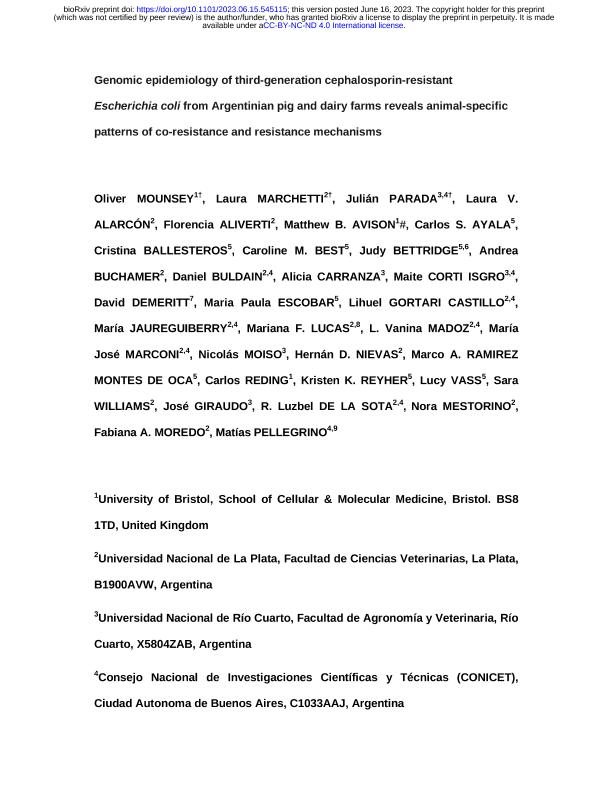Artículo
Genomic epidemiology of third-generation cephalosporin-resistant Escherichia coli from Argentinian pig and dairy farms reveals animal-specific patterns of co-resistance and resistance mechanisms
Mounsey, Oliver; Marchetti, Maria Laura ; Parada, Julian
; Parada, Julian ; Alarcon, Laura Valeria; Aliverti, Florencia; Avison, Matthew B.; Ayala, Carlos Oscar
; Alarcon, Laura Valeria; Aliverti, Florencia; Avison, Matthew B.; Ayala, Carlos Oscar ; Ballesteros, Isabel Cristina; Best, Caroline M.; Bettridge, Judy; Buchamer, Andrea Veronica; Buldain, Daniel Cornelio
; Ballesteros, Isabel Cristina; Best, Caroline M.; Bettridge, Judy; Buchamer, Andrea Veronica; Buldain, Daniel Cornelio ; Carranza, Alicia; Corti Isgro, Maite
; Carranza, Alicia; Corti Isgro, Maite ; Demeritt, David; Escobar, Maria Paula; Gortari Castillo, Lihuel
; Demeritt, David; Escobar, Maria Paula; Gortari Castillo, Lihuel ; Jaureguiberry, María
; Jaureguiberry, María ; Lucas, Mariana Florencia
; Lucas, Mariana Florencia ; Madoz, Laura Vanina
; Madoz, Laura Vanina ; Marconi, Maria Jose
; Marconi, Maria Jose ; Moiso, Nicolás Edgardo; Nievas, Hernan Dario; Ramirez Montes de Oca, Marco A.; Reding, Carlos; Reyher, Kristen K.; Vass, Lucy; Williams, Sara Inés; Giraudo, Jose Angel; de la Sota, Rodolfo Luzbel
; Moiso, Nicolás Edgardo; Nievas, Hernan Dario; Ramirez Montes de Oca, Marco A.; Reding, Carlos; Reyher, Kristen K.; Vass, Lucy; Williams, Sara Inés; Giraudo, Jose Angel; de la Sota, Rodolfo Luzbel ; Mestorino, Olga Nora; Moredo, Fabiana Alicia; Pellegrino, Matias Santiago
; Mestorino, Olga Nora; Moredo, Fabiana Alicia; Pellegrino, Matias Santiago
 ; Parada, Julian
; Parada, Julian ; Alarcon, Laura Valeria; Aliverti, Florencia; Avison, Matthew B.; Ayala, Carlos Oscar
; Alarcon, Laura Valeria; Aliverti, Florencia; Avison, Matthew B.; Ayala, Carlos Oscar ; Ballesteros, Isabel Cristina; Best, Caroline M.; Bettridge, Judy; Buchamer, Andrea Veronica; Buldain, Daniel Cornelio
; Ballesteros, Isabel Cristina; Best, Caroline M.; Bettridge, Judy; Buchamer, Andrea Veronica; Buldain, Daniel Cornelio ; Carranza, Alicia; Corti Isgro, Maite
; Carranza, Alicia; Corti Isgro, Maite ; Demeritt, David; Escobar, Maria Paula; Gortari Castillo, Lihuel
; Demeritt, David; Escobar, Maria Paula; Gortari Castillo, Lihuel ; Jaureguiberry, María
; Jaureguiberry, María ; Lucas, Mariana Florencia
; Lucas, Mariana Florencia ; Madoz, Laura Vanina
; Madoz, Laura Vanina ; Marconi, Maria Jose
; Marconi, Maria Jose ; Moiso, Nicolás Edgardo; Nievas, Hernan Dario; Ramirez Montes de Oca, Marco A.; Reding, Carlos; Reyher, Kristen K.; Vass, Lucy; Williams, Sara Inés; Giraudo, Jose Angel; de la Sota, Rodolfo Luzbel
; Moiso, Nicolás Edgardo; Nievas, Hernan Dario; Ramirez Montes de Oca, Marco A.; Reding, Carlos; Reyher, Kristen K.; Vass, Lucy; Williams, Sara Inés; Giraudo, Jose Angel; de la Sota, Rodolfo Luzbel ; Mestorino, Olga Nora; Moredo, Fabiana Alicia; Pellegrino, Matias Santiago
; Mestorino, Olga Nora; Moredo, Fabiana Alicia; Pellegrino, Matias Santiago
Fecha de publicación:
12/2023
Editorial:
American Society for Microbiology
Revista:
Applied and Environmental Microbiology
ISSN:
0099-2240
e-ISSN:
1098-5336
Idioma:
Inglés
Tipo de recurso:
Artículo publicado
Clasificación temática:
Resumen
Control measures are being introduced globally to reduce the prevalence of antibiotic resistant (ABR) bacteria on farms. However, little is known about the current prevalence and molecular ecology of ABR in key opportunistic human pathogens such as Escherichia coli on South American farms. Working with 30 dairy cattle farms and 40 pig farms across two provinces in central-easternArgentina, we report a comprehensive genomic analysis of third-generation cephalosporin resistance (3GC-R) in E. coli. 3GC-R isolates were recovered from 34.8% (cattle) and 47.8% (pigs) of samples from faecally contaminated sites. Phylogenetic analysis revealed substantial diversity suggestive of longterm horizontal transmission of 3GC-R mechanisms. Despite this, mechanismssuch as CTX-M-15 and CTX-M-2 were detected more often in dairy farms, while CTX-M-8 and CMY-2, and co-carriage of amoxicillin/clavulanate resistance and florfenicol resistance were more commonly detected in pig farms. This suggests different selective pressures of antibiotic use in these two animal types, particularly the balance of fourth- versus third-generation cephalosporin use, and of amoxicillin/clavulanate and florfenicol use. We identified the β-lactamase gene blaROB in 3GC-R E. coli, which has previously only been reported in the family Pasteurellaceae, including farmed animal pathogens. blaROB was found alongside a novel florfenicol resistance gene –ydhC - also mobilised from a pig pathogen as part of a new plasmid-mediated composite transposon, which is already widely disseminated. These data set a baseline from which to measure the effects of interventions aimed at reducing on-farm ABR and provide an opportunity to investigate zoonotic transmission of resistant bacteria in this region.
Palabras clave:
ANTIBIOTIC RESISTANT
,
E. COLI
,
CATTLE
,
PIGS
Archivos asociados
Licencia
Identificadores
Colecciones
Articulos(CCT - LA PLATA)
Articulos de CTRO.CIENTIFICO TECNOL.CONICET - LA PLATA
Articulos de CTRO.CIENTIFICO TECNOL.CONICET - LA PLATA
Citación
Mounsey, Oliver; Marchetti, Maria Laura; Parada, Julian; Alarcon, Laura Valeria; Aliverti, Florencia; et al.; Genomic epidemiology of third-generation cephalosporin-resistant Escherichia coli from Argentinian pig and dairy farms reveals animal-specific patterns of co-resistance and resistance mechanisms; American Society for Microbiology; Applied and Environmental Microbiology; 12-2023; 1-33
Compartir
Altmétricas



